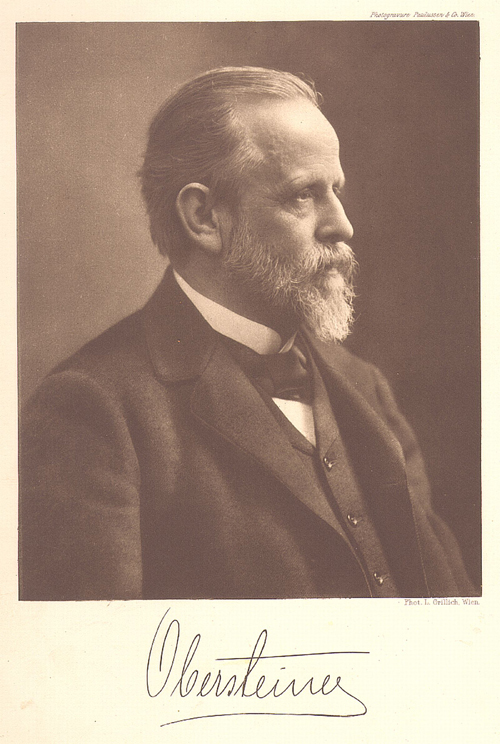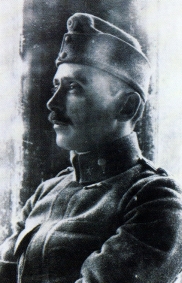|
Georg N. Koskinas
Georg N. Koskinas (1 December 1885 – 8 July 1975) was a Greek neurologist-psychiatrist. He was born on 1 December 1885 in Geraki, near Sparta. He studied medicine at the University of Athens, graduating in 1910, and trained as a resident in the Clinic of Psychiatry and Neurology of Aiginiteion Hospital under Michel Catsaras, a student of Jean-Martin Charcot (1825-1893). Career Between 1916 and 1927 he worked at the University of Vienna in neuropathology and neuroanatomy. At the Neurological Institute, his mentors in neuropathology were Heinrich Obersteiner (1847-1922) and Otto Marburg (1874-1948). In 1925 Koskinas published, with neurologist Constantin von Economo (1876-1931), the monumental ''Cytoarchitektonik der Hirnrinde des erwachsenen Menschen'' ( Cytoarchitectonics of the Adult Human Cerebral Cortex). His collaboration with neuropathologist Ernst Sträussler (1872-1959) in the Psychiatric Clinic headed by Julius Wagner-Jauregg (1857-1940) lead to several histopathol ... [...More Info...] [...Related Items...] OR: [Wikipedia] [Google] [Baidu] |
Koskinas
Koskinas ( el, Κοσκινάς) is a village in the municipality of Olympia, Elis, Greece Greece,, or , romanized: ', officially the Hellenic Republic, is a country in Southeast Europe. It is situated on the southern tip of the Balkans, and is located at the crossroads of Europe, Asia, and Africa. Greece shares land borders with .... It is 1.5 km northeast of Olympia. Populated places in Elis {{WGreece-geo-stub ... [...More Info...] [...Related Items...] OR: [Wikipedia] [Google] [Baidu] |
Greeks
The Greeks or Hellenes (; el, Έλληνες, ''Éllines'' ) are an ethnic group and nation indigenous to the Eastern Mediterranean and the Black Sea regions, namely Greece, Cyprus, Albania, Italy, Turkey, Egypt, and, to a lesser extent, other countries surrounding the Mediterranean Sea. They also form a significant diaspora (), with Greek communities established around the world.. Greek colonies and communities have been historically established on the shores of the Mediterranean Sea and Black Sea, but the Greek people themselves have always been centered on the Aegean and Ionian seas, where the Greek language has been spoken since the Bronze Age.. Until the early 20th century, Greeks were distributed between the Greek peninsula, the western coast of Asia Minor, the Black Sea coast, Cappadocia in central Anatolia, Egypt, the Balkans, Cyprus, and Constantinople. Many of these regions coincided to a large extent with the borders of the Byzantine Empire of the late 11th cent ... [...More Info...] [...Related Items...] OR: [Wikipedia] [Google] [Baidu] |
Geronthres
Geronthres ( el, Γερόνθρες), named after ancient Geronthrae, is a former municipality in Laconia, Peloponnese, Greece. Since the 2011 local government reform it is part of the municipality Evrotas, of which it is a municipal unit. The municipal unit has an area of 236.780 km2. The seat of administration was the village Geraki. The municipal population is approx. 1,800. Dutch excavations (University of Amsterdam) point to first settlement of the acropolis hill in the (Final) Neolithic period. In the Early Helladic period the site must have contained an administrative centre of some kind, judged by the sealing fragments that can be compared by those found in Lerna. Habitation continued towards the end of the Middle Helladic period, but no Mycenaean finds have been found yet. First signs of renewed habitation date from the Iron Age. The site is left again in the Roman period. Close to Geraki is the medieval fortress after which the village is named, and which formed th ... [...More Info...] [...Related Items...] OR: [Wikipedia] [Google] [Baidu] |
Jean-Martin Charcot
Jean-Martin Charcot (; 29 November 1825 – 16 August 1893) was a French neurology, neurologist and professor of anatomical pathology. He worked on hypnosis and hysteria, in particular with his hysteria patient Louise Augustine Gleizes. Charcot is known as "the founder of modern neurology",Lamberty (2007), p. 5 and his name has been associated with at least 15 medical eponyms, including #Eponyms, various conditions sometimes referred to as Charcot diseases. Charcot has been referred to as "the father of French neurology and one of the world's pioneers of neurology". His work greatly influenced the developing fields of neurology and psychology; modern psychiatry owes much to the work of Charcot and his direct followers.Bogousslavsky (2010), p. 7 He was the "foremost neurologist of late nineteenth-century France" and has been called "the Napoleon Bonaparte, Napoleon of the Neurosis, neuroses". Personal life Born in Paris, Charcot worked and taught at the famous Pitié-Salpêtri� ... [...More Info...] [...Related Items...] OR: [Wikipedia] [Google] [Baidu] |
Heinrich Obersteiner
Heinrich Obersteiner (13 November 1847 – 19 November 1922) was an Austrian neurologist born in Vienna. In 1870 earned his doctorate from the University of Vienna, where he worked in the laboratory of Ernst Wilhelm von Brücke (1819–1892). In 1873 he earned his habilitation for pathology and anatomy of the nervous system at the University of Vienna, becoming an associate professor in 1880, and receiving the title of "full professor" in 1898. He was also director of a private mental institution at Oberdöbling, outside of Vienna. In 1882 he established an internationally known neurological institute in Vienna. The eponymous Obersteiner–Redlich line is named after him, along with Emil Redlich (1866–1930). This zone is where the central nervous system and peripheral nervous system meet, as well as the place where Schwann cells meet oligodendroglia cells. Written works * '' Anleitung beim Studium des baues der nervösen Centralorgane im gesunden und kranken Zustande''. L ... [...More Info...] [...Related Items...] OR: [Wikipedia] [Google] [Baidu] |
Otto Marburg
Otto Marburg (May 25, 1874 – June 13, 1948) was an Austrian neurologist known for his contributions to the understanding of multiple sclerosis and for advances in neurooncology. Marburg was born in Römerstadt in Moravia, Austria-Hungary (today Rýmařov, Czech Republic). He was Jewish.Lewis P. Rowland, ''The legacy of Tracy J. Putnam and H. Houston Merritt: modern neurology in the United States'', Oxford University Press (2008), p. 62 From 1919 to 1938 he was head of the Neurological Institute at the University of Vienna. Following the 1938 Anschluss, Marburg was forced to emigrate to the United States as a refugee. Arriving in New York City, he joined Columbia University's College of Physicians and Surgeons as clinical professor of neurology. He was author of several standard texts about the nervous system, and a subtype of multiple sclerosis (Marburg multiple sclerosis) has been named after him. Marburg died of cancer in New York in 1948, at the age of 74. Otto Mar ... [...More Info...] [...Related Items...] OR: [Wikipedia] [Google] [Baidu] |
Constantin Von Economo
Constantin Freiherr von Economo ( gr, Κωνσταντίνος Οικονόμου; 21 August 1876 – 21 October 1931) was an Austrian psychiatrist and neurologist of Greek descent, born in modern-day Romania (then Ottoman Empire). He is mostly known for his discovery of encephalitis lethargica and his atlas of cytoarchitectonics of the cerebral cortex. Biography Youth and schooling Constantin Economo von San Serff was born in Brăila, Romania, to Johannes and Helene Economo, a wealthy family with large holdings in Thessaly and Macedonia. The Economo (Οικονόμου, '' Oikonomou'') family originated from Edessa, in the Ottoman Sanjak of Salonica (modern Edessa, Central Macedonia, Greece) where some of Constantin's ancestors were notables, and his family included many bishops. In 1877, the family moved to Trieste, Austria-Hungary,Economo, K. (1932). ''Constantin Freiherr von Economo''. Wien: Mayer & Co. and Constantin spent his childhood and youth in Trieste. He wa ... [...More Info...] [...Related Items...] OR: [Wikipedia] [Google] [Baidu] |
Cytoarchitectonics Of The Cerebral Cortex
Cytoarchitecture (Greek '' κύτος''= "cell" + '' ἀρχιτεκτονική''= "architecture"), also known as cytoarchitectonics, is the study of the cellular composition of the central nervous system's tissues under the microscope. Cytoarchitectonics is one of the ways to parse the brain, by obtaining sections of the brain using a microtome and staining them with chemical agents which reveal where different neurons are located. The study of the parcellation of ''nerve fibers'' (primarily axons) into layers forms the subject of myeloarchitectonics ( History of the cerebral cytoarchitecture Defining cerebral cytoarchitecture began with the advent of —the science of slicing a ...[...More Info...] [...Related Items...] OR: [Wikipedia] [Google] [Baidu] |
Ernst Sträussler
Ernst Sträussler (June 17, 1872, Ungarisch-Hradisch – July 11, 1959, Vienna) was an Austrian neuropathologist born in the Moravian city of Ungarisch-Hradisch. In 1895 he earned his medical doctorate at the University of Vienna, and afterwards worked at the psychiatric clinic of Julius Wagner-Jauregg (1857–1940). In 1907 he was habilitated for psychiatry and neurology in Prague, where in 1915 he attained the title of professor extraordinary. In 1919 he returned to Vienna.Ernst Sträussler @ Sträussler is remembered for his work in psychiatry, as well as his research involving th ... [...More Info...] [...Related Items...] OR: [Wikipedia] [Google] [Baidu] |
Julius Wagner-Jauregg
Julius Wagner-Jauregg (; 7 March 1857 – 27 September 1940) was an Austrian physician, who won the Nobel Prize in Physiology or Medicine in 1927, and is the first psychiatrist to have done so. His Nobel award was "for his discovery of the therapeutic value of malaria inoculation in the treatment of dementia paralytica". Early life Julius Wagner-Jauregg was born Julius Wagner on 7 March 1857 in Wels, Upper Austria, the son of Adolph Johann Wagner and Ludovika Jauernigg Ranzoni."Physiology or medicine, 1922-1941" Jan Lindsten. World Scientific, 1999. p. 170. , . His family name was changed to "Wagner von Jauregg" when his father was given the title of " |
General Paresis Of The Insane
General paresis, also known as general paralysis of the insane (GPI), paralytic dementia, or syphilitic paresis is a severe neuropsychiatric disorder, classified as an organic mental disorder and is caused by late-stage syphilis and the chronic meningoencephalitis and cerebral atrophy that are associated with this late stage of the disease when left untreated. GPI differs from mere paresis, as mere paresis can result from multiple other causes and usually does not affect cognitive function. Degenerative changes caused by GPI are associated primarily with the frontal and temporal lobar cortex. The disease affects approximately 7% of individuals infected with syphilis, and is far more common in third world countries where fewer options for timely treatment are available. It is more common among men. GPI was originally considered to be a type of madness due to a dissolute character, when first identified in the early 19th century. The condition's connection with syphilis was dis ... [...More Info...] [...Related Items...] OR: [Wikipedia] [Google] [Baidu] |
Syphilis
Syphilis () is a sexually transmitted infection caused by the bacterium ''Treponema pallidum'' subspecies ''pallidum''. The signs and symptoms of syphilis vary depending in which of the four stages it presents (primary, secondary, latent, and tertiary). The primary stage classically presents with a single chancre (a firm, painless, non-itchy skin ulceration usually between 1 cm and 2 cm in diameter) though there may be multiple sores. In secondary syphilis, a diffuse rash occurs, which frequently involves the palms of the hands and soles of the feet. There may also be sores in the mouth or vagina. In latent syphilis, which can last for years, there are few or no symptoms. In tertiary syphilis, there are gummas (soft, non-cancerous growths), neurological problems, or heart symptoms. Syphilis has been known as "the great imitator" as it may cause symptoms similar to many other diseases. Syphilis is most commonly spread through sexual activity. It may also be transmi ... [...More Info...] [...Related Items...] OR: [Wikipedia] [Google] [Baidu] |


_–_Gerd_Hruška.png)